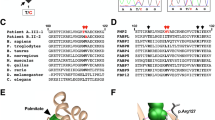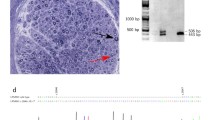Abstract.
Charcot-Marie-Tooth disease type 1B (CMT 1B) is caused by mutations in the gene coding for peripheral myelin protein zero (MPZ, P0) that plays a fundamental role in adhesion and compaction of peripheral myelin. Here we report a Costa Rican family with a hereditary peripheral neuropathy due to a novel Tyr145Ser MPZ mutation. Four family members were heterozygously affected; two siblings of two heterozygous carriers were homozygous for this mutation. On neurological examination the heterozygous parents and their homozygous children both showed distal sensory deficits. The mother and the siblings displayed impaired deep tendon reflexes and mild sensory ataxia. The homozygous individuals were more severely affected with an earlier age of onset, distal motor weakness, and pupillary abnormalities. Electrophysiological studies revealed both signs of demyelination and axonal nerve degeneration. The sural nerve biopsy of one sibling showed thinly myelinated nerve fibers, onion bulb formation, and clusters of regenerating fibers. On electron microscopy axonal degeneration and decompaction of inner myelin layers were found. This Costa Rican family shows phenotypic variability depending on the homozygous or heterozygous state of the Tyr145Ser mutation carriers.



Similar content being viewed by others
References
Dyck P, Chance P, Lebo R, Carney J (1993) Hereditary motor and sensory neuropathies. In: Dyck P, Thomas P, Griffin J, Low P, Poduslo J (eds) Peripheral neuropathies. Saunders, Philadelphia, pp 1094–1136
Nelis E, Haites N, Van Broeckhoven C (1999) Mutations in the peripheral myelin genes and associated genes in inherited peripheral neuropathies. Hum Mutat 13:11–28
Lupski JR, Oca-Luna RM de, Slaugenhaupt S, Pentao L, Guzzetta V, Trask BJ, Saucedo-Cardenas O, Barker DF, Killian JM, Garcia CA, Chakravarti A, Patel PI (1991) DNA duplication associated with Charcot-Marie-Tooth disease type 1A. Cell 66:219–232
Timmerman V, Nelis E, Van Hul W, Nieuwenhuijsen BW, Chen KL, Wang S, Ben Othman K, Cullen B, Leach RJ, Hanemann CO, et al (1992) The peripheral myelin protein gene PMP-22 is contained within the Charcot-Marie-Tooth disease type 1A duplication. Nat Genet 1:171–175
Hayasaka K, Himoro M, Sato W, Takada G, Uyemura K, Shimizu N, Bird TD, Conneally PM, Chance PF (1993) Charcot-Marie-Tooth neuropathy type 1B is associated with mutations of the myelin P0 gene. Nat Genet 5:31–34
Lemke G (1988) Unwrapping the genes of myelin. Neuron 1:535–543
Sutcliffe JG (1988) The genes for myelin revisited. Trends Genet 4:211–213
Filbin MT, Walsh FS, Trapp BD, Pizzey JA, Tennekoon G (1990) Role of myelin P0 protein as a homophilic adhesion molecule. Nature 344:871–872
Wong MH, Filbin MT (1996) Dominant-negative effect on adhesion by myelin Po protein truncated in its cytoplasmic domain. J Cell Biol 134:1531–1541
Berger P, Young P, Suter U (2002) Molecular cell biology of Charcot-Marie-Tooth disease. Neurogenetics 4:1–15
Hattori N, Yamamoto M, Yoshihara T, Koike H, Nakagawa M, Yoshikawa H, Ohnishi A, Hayasaka K, Onodera O, Baba M, Yasuda H, Saito T, Nakashima K, Kira J, Kaji R, Oka N, Sobue G (2003) Demyelinating and axonal features of Charcot-Marie-Tooth disease with mutations of myelin-related proteins (PMP22, MPZ and Cx32): a clinicopathological study of 205 Japanese patients. Brain 126:134–151
Warner LE, Hilz MJ, Appel H, Killian JM, Kolodny EH, Carpenter S, Watters GV, Wheeler C, Witt D, Bodell A, Nelis E, Van Broeckhoven C, Lupski JR (1996) Clinical phenotypes of different mpz (P0) mutations may include Charcot-Marie-Tooth type 1B, Dejerine-Sottas, and congenital hypomyelination. Neuron 17:451–460
Plante-Bordeneuve V, Guiochon-Mantel A, Lacroix C, Lapresle J, Said G (1999) The Roussy-Levy family: from the original description to the gene. Ann Neurol 46:770–773
De Jonghe P, Timmerman V, Ceuterick C, Nelis E, De Vriendt E, Löfgren A, Vercruyssen A, Verellen C, Van Maldergem L, Martin J, Van Broeckhoven C (1999) The Thr124Met mutation in the peripheral myelin protein zero (MPZ) gene is associated with a clinically distinct Charcot-Marie-Tooth phenotype. Brain 122:281–290
Chapon F, Latour P, Diraison P, Schaeffer S, Vandenberghe A (1999) Axonal phenotype of Charcot-Marie Tooth disease associated with a mutation in the myelin protein zero gene. J Neurol Neurosurg Psychiatry 66:779–782
Nelis E, Timmerman V, De Jonghe P, Vandenberghe A, Pham Dinh D, Dautigny A, Martin JJ, Van Broeckhoven C (1994) Rapid screening of myelin genes in CMT1 patients by SSCP analysis: identification of new mutations and polymorphisms in the P0 gene. Hum Genet 94:653–657
Preston DC, Shapiro BE (1998) Electromyography and neuromuscular disorders. Butterworth-Heinemann, Boston
Ikegami T, Nicholson G, Ikeda H, Ishida A, Johnston H, Wise G, Ouvrier R, Hayasaka K (1996) A novel homozygous mutation of the myelin Po gene producing Dejerine-Sottas disease (hereditary motor and sensory neuropathy type III). Biochem Biophys Res Commun 222:107–110
Parman Y, Plante-Bordeneuve V, Guiochon-Mantel A, Eraksoy M, Said G (1999) Recessive inheritance of a new point mutation of the PMP22 gene in Dejerine-Sottas disease. Ann Neurol 45:518–522
Bienfait HM, Baas F, Gabreels-Festen AA, Koelman JH, Langerhorst CT, Visser M de (2002) Two amino-acid substitutions in the myelin protein zero gene of a case of Charcot-Marie-Tooth disease associated with light-near dissociation. Neuromuscul Disord 12:281–285
Gabreëls-Festen AA, Hoogendijk JE, Meijerink PH, Gabreëls FJ, Bolhuis PA, Beersum S van, Kulkens T, Nelis E, Jennekens FG, Visser M de, Engelen BG van, Van Broeckhoven C, Mariman EC (1996) Two divergent types of nerve pathology in patients with different P0 mutations in Charcot-Marie-Tooth disease. Neurology 47:761–765
Marrosu MG, Vaccargiu S, Marrosu G, Vannelli A, Cianchetti C, Muntoni F (1998) Charcot-Marie-Tooth disease type 2 associated with mutation of the myelin protein zero gene. Neurology 50:1397–1401
Rautenstrauss B, Nelis E, Grehl H, Pfeiffer RA, Van Broeckhoven C (1994) Identification of a de novo insertional mutation in P0 in a patient with a Déjérine-Sottas phenotype. Hum Mol Genet 3:1701–1702
Senderek J, Hermanns B, Lehmann U, Bergmann C, Marx G, Kabus C, Timmerman V, Stoltenburg-Didinger G, Schroder JM (2000) Charcot-Marie-Tooth neuropathy type 2 and P0 point mutations: two novel amino acid substitutions (Asp61Gly; Tyr119Cys) and a possible "hotspot" on Thr124Met. Brain Pathol 10:235–248
Young P, Grote K, Kuhlenbaumer G, Debus O, Kurlemann H, Halfter H, Funke H, Ringelstein EB, Stogbauer F (2001) Mutation analysis in Chariot-Marie Tooth disease type 1: point mutations in the MPZ gene and the GJB1 gene cause comparable phenotypic heterogeneity. J Neurol 248:410–415
Giese KP, Martini R, Lemke G, Soriano P, Schachner M (1992) Mouse P0 gene disruption leads to hypomyelination, abnormal expression of recognition molecules, and degeneration of myelin and axons. Cell 71:565–576
Frei R, Motzing S, Kinkelin I, Schachner M, Koltzenburg M, Martini R (1999) Loss of distal axons and sensory Merkel cells and features indicative of muscle denervation in hindlimbs of P0-deficient mice. J Neurosci 19:6058–6067
Martini R, Zielasek J, Toyka KV, Giese KP, Schachner M (1995) Protein zero (P0)-deficient mice show myelin degeneration in peripheral nerves characteristic of inherited human neuropathies. Nat Genet 11:281–286
Carenini S, Maurer M, Werner A, Blazyca H, Toyka KV, Schmid CD, Raivich G, Martini R (2001) The role of macrophages in demyelinating peripheral nervous system of mice heterozygously deficient in p0. J Cell Biol 152:301–308
Bollensen E, Steck AJ, Schachner M (1988) Reactivity with the peripheral myelin glycoprotein P0 in serum from patients with monoclonal IgM gammopathy and polyneuropathy. Neurology 38:1266–1270
D'Urso D, Brophy PJ, Staugaitis SM, Gillespie CS, Frey AB, Stempak JG, Colman DR (1990) Protein zero of peripheral nerve myelin: biosynthesis, membrane insertion, and evidence for homotypic interaction. Neuron 4:449–460
Xu W, Shy M, Kamholz J, Elferink L, Xu G, Lilien J, Balsamo J (2001) Mutations in the cytoplasmic domain of P0 reveal a role for PKC-mediated phosphorylation in adhesion and myelination. J Cell Biol 155:439–446
Ekici AB, Oezbey S, Fuchs C, Nelis E, Van Broeckhoven C, Schachner M, Rautenstrauss B (2002) Tracing Myelin Protein Zero (P0) in vivo by construction of P0-GFP fusion proteins. BMC Cell Biol 3:29
Schroder JM, Himmelmann F (1992) Fine structural evaluation of altered Schmidt-Lanterman incisures in human sural nerve biopsies. Acta Neuropathol (Berl) 83:120–133
Ohnishi A, Aoki A, Yamamoto T, Tsuji S (2000) A case of Charcot-Marie-Tooth disease 1 B with Val 146Phe mutation of myelin protein zero showing a severe clinical phenotype. Rinsho Shinkeigaku 40:268–270
Zhang K, Filbin MT (1998) Myelin Po protein mutated at Cys21 has a dominant-negative effect on adhesion of wild type Po. J Neurosci Res 53:1–6
Acknowledgements.
We thank the family members who collaborated in this study for giving their informed consent, blood samples, and the biopsy. Support form the Vicerrectoría de Investigación, University of Costa Rica is gratefully acknowledged (project 742-98-241). A.L. is a recipient of a scholarship from the Deutscher Akademischer Austauschdienst. This study was supported by the Deutsche Forschungsgemeinschaft and Deutsche Gesellschaft für Muskelkranke (DGM, AFM) (to B.R.) and by the ELAN funds (to D.H.). All experiments performed comply with current laws in Costa Rica and Germany.
Author information
Authors and Affiliations
Corresponding author
Additional information
A. Leal and C. Berghoff contributed equally to this work.
Rights and permissions
About this article
Cite this article
Leal, A., Berghoff, C., Berghoff, M. et al. Charcot-Marie-Tooth disease: a novel Tyr145Ser mutation in the myelin protein zero (MPZ, P0) gene causes different phenotypes in homozygous and heterozygous carriers within one family. Neurogenetics 4, 191–197 (2003). https://doi.org/10.1007/s10048-003-0153-0
Received:
Accepted:
Published:
Issue Date:
DOI: https://doi.org/10.1007/s10048-003-0153-0




